![]() One of the hosts of an immensely popular golf podcast recently said, on the air, that “custom club fitting is a total waste of time for most people.”
One of the hosts of an immensely popular golf podcast recently said, on the air, that “custom club fitting is a total waste of time for most people.”
It was the type of statement that boosts ratings and incites debate among golf industry insiders.
But his reasoning was weak; “It’s not like real life,” he said. “You’re hitting off a matt.”
Just because club fitting isn’t conducted on the course — with wind, rotten lies and incessant heckling from beer-drinking buddies — doesn’t mean it’s worthless. If it was, no one would be doing it.
These are the fundamental questions that drive the debate around club fitting:
Does the average, struggling golfer actually benefit from custom club fitting? Is he a savvy, well-informed equipment consumer who knows something the rest of us don’t know, or is he just a sucker, throwing away money on a shiny new placebo?
Does he walk out with better clubs, a better game, or both? Is club fitting a waste of time for people who do not play at an elite level? And what do you really get from a $350 club fitting session at one of the fancy new club fitting boutiques?

On one hand, a dynamic club fitting session is the only way to know, for sure, that you’re getting clubs that match your swing.
But as I’ve learned first hand, it’s also an easy way to spend an inordinate amount of time and money on shiny new clubs that only produce miniscule improvement in Track Man numbers. Everyone knows that a tiny improvement on a launch monitor does not necessarily translate to better golf scores.
Full disclosure: I do marketing in the golf industry. I’ve worked with several companies that offer club fitting services but this is NOT a paid post or a promotion of any kind. Just my overview of what’s happening in that business and my own, personal experience with four different club fitters.
Basically, I’ve been drinking the club fitting kool-aid for 25 years, but what I’ve experienced recently really tests my faith. Even though custom club fitting is more prevalent than ever, I’m not sure that business is moving in a direction that benefits the average consumer.
One other thing: I am not an equipment junkie. I’m not one to run out and buy the latest, greatest anything. I hang onto my clubs, probably longer than I should, and I play more by feel than by data analysis.
I currently play to an 8 handicap, but I was a 5, once upon a time, while playing with a set of Ping knock-offs made for me by a trusted old craftsman we called Uncle Milty.
It’s a story with more wrinkles than an Arizona centenarian and it begins back in the day of leather-wrapped grips and persimmon woods.
Tinkering with persimmon… The origins of custom club fitting.
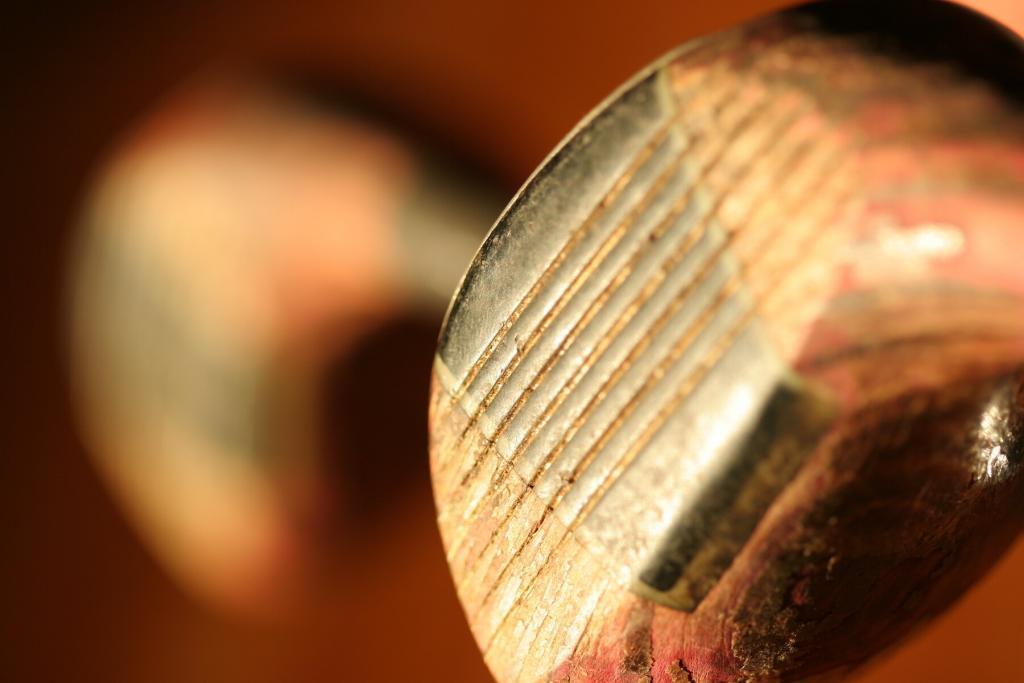
Club fitting, to some degree or another, has always been popular on the PGA tour. Arnold Palmer was famous for tinkering with his clubs. He probably set his hands on more golf clubs than anyone in the history of the game.
Palmer was on a lifelong quest for the perfect club, and said he never found it. He based his preferences on two things: how the club felt and how it looked. He believed that if it looked good, and felt right in his hands, he’d make it work.
John S. Ford did repair work for Palmer for several years in the early 80’s. “Mr. Palmer always wanted his leather grips wrapped in a very precise way, with a piece of coat hanger underneath,” Ford said.
“And when I was building drivers at McGregor, Mr. Nicklaus wanted the toe rolled off. That’s just what he liked. And sometimes we’d add lead counterweights inside his shafts. He could tell if a club was just a gram off.”
Pros of that era would add a little lead tape here and there, grind the soles, whittle the persimmon and bend the lie angles just so. It was more art than anything. They had no way to measure what they were doing; they were just eyeballing it and testing it on the course.
Trial and error.
That’s pretty much the way it was until the 1970s when Dr. Joe Braly added a little bit of science to the art of club fitting.
Early Custom Club fitting — Matching shafts throughout a set.
Braly was an ex fighter pilot, aeronautical engineer and avid golfer who invented a way to sort and verify shafts according to stiffness. His goal was to turn untested blank shafts into matching sets that the tour pros could trust.
Emphasis on “matching.” To this day, most sets of clubs do not have all 14 shafts nicely matched.
To understand club fitting you have to understand Braly’s game-changing invention: The frequency machine. To this day it’s one of the main tools of the trade.
Frequency analyzers measure the oscillation of a shaft using a laser beam. The stiffer the shaft, the faster the rate of oscillation; the more flexible the shaft, the slower the oscillation.
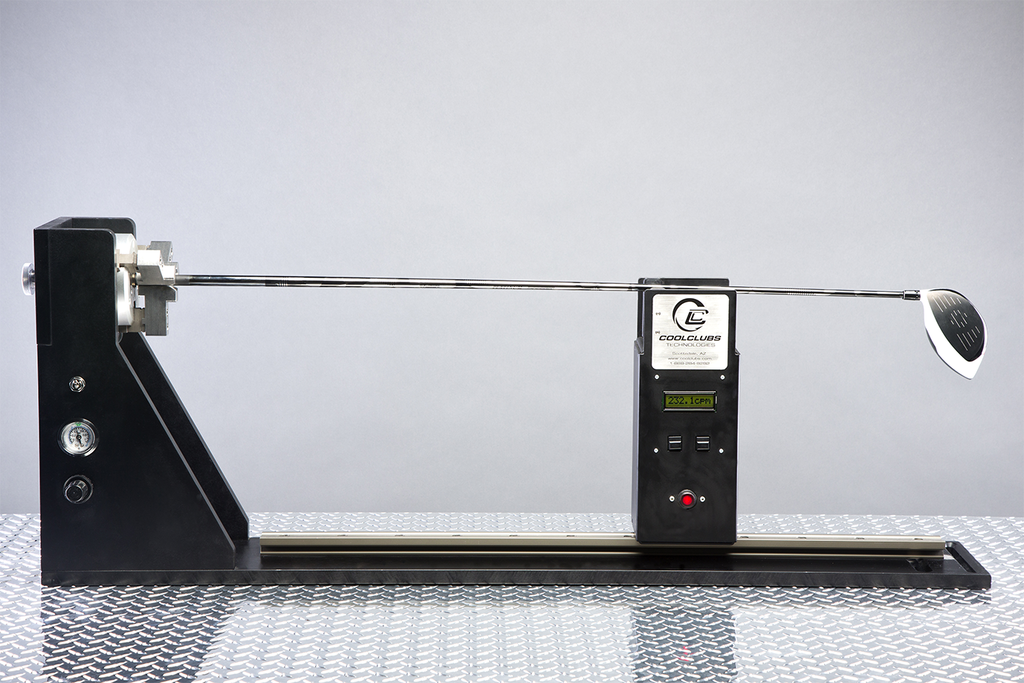
Here’s how they work: Clamp the grip end into the frequency machine, then pull the clubhead back, let it go and watch the shaft oscillate back and forth.
The frequency analyzer counts the oscillation rate and displays it in the form of “cycles per minute” on an LED display. So Braly could assign a number to each shaft. He then built a set of clubs using only the shafts with matching numbers.
The idea caught on… Working with his son, Kim, they opened a repair van on the PGA tour circuit and by 1978 they had more than 100 tour players using their FM Precision Shafts. The two went on to start Project X and now KBS shafts.
The general public, however, didn’t see the benefit of Braly’s invention until a small, Idaho-based company called Henry Griffits brought custom club fitting to country clubs everywhere and began to tap that untapped, unproven market.
Building a business model around an unknown service: club fitting.
Henry Griffits, now known as HG, was started by Randy Henry and Jim Griffitts in 1983. I was introduced to that world by the CEO in 2001. Jim Hofmeister treated me to a tour of their facility and gave me a thorough briefing on their unique approach to fitting and hand-crafting personalized golf clubs.
HG developed the processes and patented many of the tools that club fitters still use. At that time the closest thing was PING’s color coding system, but that paled in comparison to what HG offered. It was a first in golf industry marketing.
“First and foremost, Randy Henry was an instructor,” Hofmeister said. “He didn’t set out to build a club company, he just did what he felt he had to do to get the right clubs for his students — the clubs that matched the swing that he was helping them build.”
That was the first time I ever saw a frequency machine used to test the consistency of shaft flex, and I have to admit I was stunned. I had no idea that a “set” of brand name irons could be so completely screwed up.
That was my first ah-ha moment, and lesson #1 in club fitting: The shaft manufacturing process is far from perfect.
At HG they had stacks of reject shafts that were set to go back to the manufacturer. Hofmeister put one on the frequency machine and showed me the problem; He couldn’t even get a reading. Instead of oscillating back and forth, it just bounced all over the place.
HG and other custom club makers who set tight tolerances for shaft flex consistency routinely reject 15 to 25% of their shafts. Every time. But the manufacturing process of mass-marketed clubs does not involve frequency testing of every shaft. So at least two out of your set of 14 are likely to be mis-matched, even if you’ve been through a fitting.
The labels are also misleading. Every shaft manufacturer and every big golf brand has a whole different spectrum of “stiff” shafts, “ladies” shafts and every other shaft category. There are no industry standards for shaft flex. One company’s “stiff” shaft is another company’s regular shaft.
Not only that, shaft flex can vary dramatically from one club to the next within a set of so-called regular flex clubs. Especially when you’re talking graphite shafts. So a follow-up fitting after your clubs are built is the only way to confirm that you’re getting what you paid for.
The other thing that all good club fitters emphasize is getting the lie angles right.
If a golfer is playing with clubs that are too flat or too upright, he’s going to adopt all sorts of bad habits in order to compensate for the mis-fit clubs. He’ll figure out a creative way to make the ball go where he wants it to go, which leads to a lot of bad habits.
As Hofmeister told me, “Equipment affects motion.”

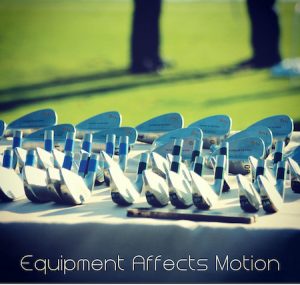
That look behind the curtain at Henry-Griffitts planted a seed of doubt in my head that will never go away. Once you’ve seen a set of brand name, off-the-shelf irons tested and plotted on a frequency chart, you can’t unsee it.
So I left Idaho thinking “how can anyone trust the clubs they’re swinging if they buy right off the shelf? There’s no way the big manufacturers take time to test every shaft before assembly. ”
When I returned home I contacted Andy Heinly, the local Henry-Griffitts guy, and went through the entire club fitting process. I was sold hook, line and sinker.
Upon delivery of my HG irons Andy did a follow-up fitting to confirm the lie angles and the shaft consistency of every club in my bag. That was before the days of the Track Man and he could tell, just by watching ball flight, that I got exactly what I paid for.
I’ll never forget how well I was hitting the ball after getting those clubs and doing a lesson with Andy. Part of it was the clubs, part of it was the instruction, and part of it was mental.
That’s their secret sauce at HG; The clubs and the swing instruction are perfectly in sync. They recruit and train teaching professionals to combine fittings with teaching. If you can’t teach, you can’t sell Henry-Griffitts clubs.
It’s a great way for teaching pros to earn extra money, plus it dramatically improves their odds of success with every student. As Andy told me, “A lot of guys come to me, and I just have to say I can’t teach you with those clubs you’re using. It’ll be a waste of time for both of us.”
But most people in the golf business believe club fitting and instruction should be completely separated. Like church and state.
Club fitters do the best they can with the swing their clients bring on any given day. They don’t try to teach because PGA pros get quite possessive when a fitter encroaches on their rarified turf.
But here’s what both camps have in common; they’re trying to help build your confidence. Whether it’s with one new club, or a series of lessons, or a combination of a full club fitting session plus lessons, the end goal is the same.
I can testify to how that feels when it all comes together. That buying process I went through with Andy provided the one thing that every golfer will pay for: Confidence.
I had confidence in the irons themselves, confidence in HG’s building process, in the fitter and perhaps even in even my swing.
It seemed like I was making a better swing with my new clubs. Maybe that was Andy’s expert tutelage. Maybe that was just my imagination. Maybe it was just the placebo effect. (Never underestimate the placebo effect on a fragile golfer’s psyche.)
It doesn’t really matter, because the confidence was real.
Three keys to consumer behavior in golf: Shiny objects, doubt, and more distance.
Golfers buy for completely irrational, emotional reasons and then conjure up all sorts of logical rationale for our purchase of those objects.
My first club fitting experience provided the ultimate purchase rationalization: “Of course I needed new clubs honey, my old ones didn’t fit me. The lie angles were off and the shafts weren’t frequency matched.”
There’s another subtle mental benefit to club fitting that’s worth mentioning… That little voice in your head that says “my equipment’s better than your equipment.”
At the amateur level If you’re playing in a tournament head-to-head against a guy with stock clubs, your equipment becomes a competitive advantage.
At the elite level club fitting is standard operation procedure. So you have to do it just to keep up with everyone else in the field. You can’t NOT get fit because you can’t afford any tinge of doubt about your equipment.
Doubt sells a lot of golf clubs, and it seems to be a key selling point for the new breed of club fitting operations. Doubt and the fragile golf ego.
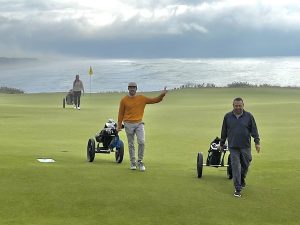
Doubt is what drove me to replace my reliable HG driver after five years of good performance.
Somehow I got it in my head that I was giving up distance by playing steel shafts. So on a whim during a trip to Bandon Dunes, I “upgraded” to an Adams driver with a lighter, graphite shaft.
If I had compared the two drivers on a launch monitor I’m quite sure I wouldn’t have made that purchase.
Instead, I spent the next five years trying to convince myself that it was a smart buy. Ego prevailed over buyer’s remorse and prevented me from cutting my losses and moving on. Even though I was missing more fairways I couldn’t admit that I had made a bad purchase.
Finally I swallowed my pride and decided that driver needed to go. I wanted that feeling of confidence again. Plus, I had a hankering for something shiny and new. I wanted an entirely new set. I deserved it.
Luckily I didn’t have to walk into a big box store completely blind and trust some random sales guy to fit me properly. I went back to my fitter/instructor who sold me my HG irons all those years ago. Andy Heinly now owns a golf shop offering all the big name brands and all the latest, greatest launch monitors to help gauge what’s best for me.
He adheres to the old truism in club fitting that says “90% of you are going to be better off with a shaft that’s more flexible than what you think you need.”
Plus, Andy knows my swing and he recognizes that I’m not getting any younger. So he put me in a set of Callaway Apex irons with lightweight graphite shafts that seemed significantly more flexible than my steel shafted HGs.
They felt weird, fast and easy to swing. But Andy assured me that it was the right move, and I had no reason to doubt him. Besides, the launch monitor data confirmed that they “worked better” across the board.
But did they, really?
I don’t recall any detailed A-B testing on the dispersion pattern of the Callaways versus the old HGs. But I do remember that I was getting more distance.
Maybe I was momentarily taken by the age-old golf industry sales pitch of a few more yards. But I know better!
It’s common knowledge that the big brands have been steadily decreasing the loft on their irons in order to deliver on that overused promise. In his book, The Search For The Perfect Club, Tom Wishon calls it The Dreaded Vanishing Loft Disease. So that new Callaway 7 iron was equal to my HG 6 iron.
I was not comparing apples to apples, and frankly, I didn’t care. I was dead set on getting new clubs so those Track Man numbers fit perfectly with my pre-conceived notion of what I needed.
I only saw what I wanted to see. Heard what I wanted to hear.
Even though it was bit of a blow to my golfing ego I went with Andy’s recommendation to use iron shafts that were on the softer side of the “regular” flex spectrum. From that particular shaft manufacturer anyway. (Matrix Recoil ES 760/F3)
When my new set of Callaways arrived Andy took time to check the lie angles and confirm the launch parameters, especially with the driver. A quick click click with his handy wrench and my new driver was launching them quite nicely with a “smash factor” that was very close to perfect. I was getting every inch of distance I could get out of my swing speed.
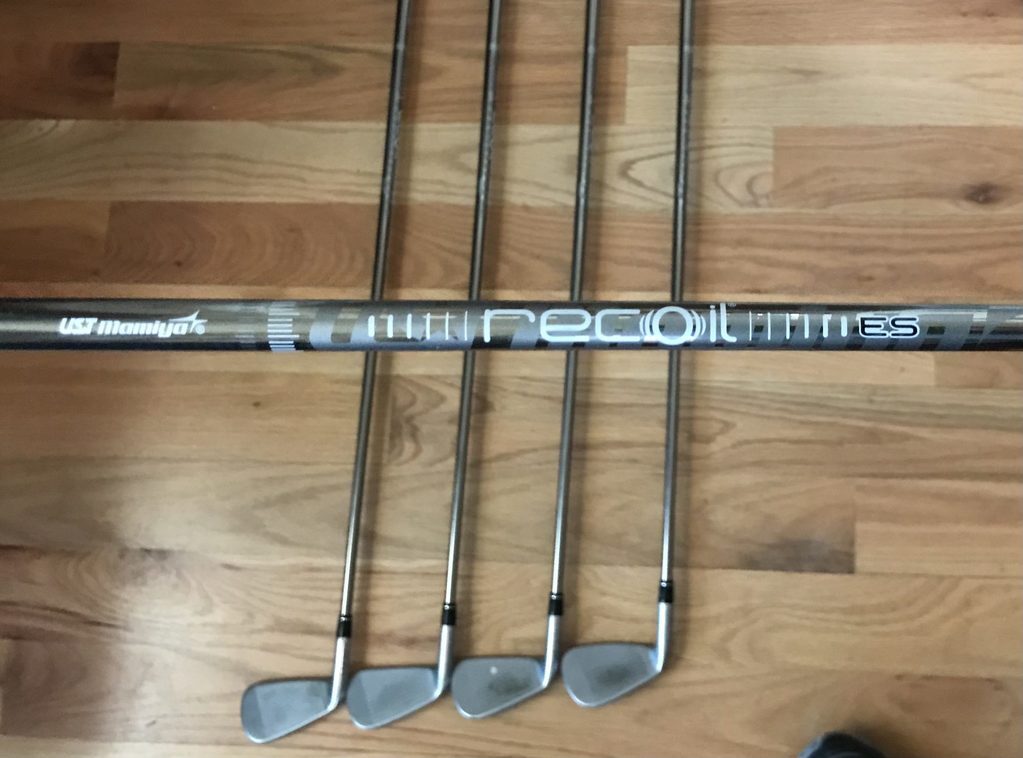
I started feeling pretty good about myself, especially when I realized I was wielding a 9 degree driver. That’s contrary to everything I’d heard about how most people need more loft with the driver, not less.
But the dynamics of club fitting are such that a 9 degree driver in my hands behaves differently than the same 9 degree driver for the next guy with a different shaft. It was producing optimal launch angle for me, which in reality was more like 10 degrees, not nine.
It’s the way I deliver the club into the ball, in addition to an endless combination of other variables. There are so many different variables involved, it’s ridiculous.
Wishon lists 21 different variables in club fitting, but he’s only talking about the measurable stuff that he can control, like lie angles, swing weight, shaft spine alignment, shaft torque, frequency, etc etc.
We can’t forget about the “real life” variables that the podcast host was referring to. Like “feel,” how the club interacts with the grass, and they type of ball you play. (He contends that hitting practice balls off a matt just doesn’t cut it.)
In real life my new Callaway clubs are performing quite well. My handicap went down, I’ve hit some of the best iron shots of my life, my misses have been better, and I posted two even-par rounds. I’ve never played even par golf in my life.
I had absolutely no complaints about the clubs Andy sold me until I started doing research for this article. The deeper down the rabbit hole I went, the worse it got.
Blinded by bling – and too many choices.
High-end club fitting boutiques have popped up all over the country in the last 10 years. Companies like Cool Clubs, True Spec, Hot Stix, Club Champion and GOLFTEC didn’t exist when I bought my last set, so I was very curious to see what they offered.
I made an appointment with a club fitter at one of the “brand agnostic” operations, meaning they carry a dazzling array of colorful shafts and high tech clubheads from dozens of major manufacturers. They claim to offer more than 50,000 different possible combinations.
Perfect for the guys who buy golf clubs like women buy jewelry. For me it was more like mix and match till my head explodes!
After a quick warm and a couple questions about my game, the fitter fired up the Track Man and started assessing data from my 6 iron shots. 173 yards of carry from 82 miles per hour of clubhead speed. “Not too bad,” he said.
With that data point established he headed over to the frequency machine. (He did not check my lie angles.) He tested my six iron and determined that 291 was the current frequency number.
“Oh, these shafts are way too soft for your clubhead speed,” he announced. “These are like super soft ladies flex.”
“No way,” I said. “I ordered light weight, regular flex shafts and we confirmed that.”
“Well, I got the numbers right here. It must have been the build that they did at Callaway,” he said. “They probably tipped ‘em wrong so they came out much softer than what the factory specs say.”
Oooookay. Never heard of that, but since my Callaways had never been on a frequency machine I couldn’t deny that possibility.
My head was spinning, my ego was bruised and the seed of doubt was firmly planted. I was thinking, there’s no way Andy put me in a set of granny shafts that are so soft you couldn’t smash a rotten pumpkin.
At that moment, if I didn’t know any better, I would have taken the bait. But the more I thought about it, the more far fetched it sounded. Andy confirmed the lie angle and the launch of each club after delivery. I’m pretty sure he would have seen some weird dispersion pattern or launch angle anomalies if Callaway mistakenly gave me a whole set of Granny-shafted irons.
In any case, I went along with the fitter’s assessment because I wanted to hear what what else he had to say. Besides, there were all those pretty shafts to try.
One that looked particularly enticing was $400. For one shaft! I opted to NOT test that one for fear that it would produce the best numbers of the bunch and I would be somehow morally obligated to buy the entire bank-breaking set.
As he changed out clubheads and tried different shaft combinations one thing became quite clear: the shot pattern produced by my Callaway irons was pretty damn good. The baseline was high. Nothing I tried that day showed a dramatic improvement in both ball speed and dispersion, relative to the clubs I already had.
The fitter told me, “Your driver’s fine. Don’t change a thing.” He also told me that my Apex clubheads were very good, and were out performing many of the clubheads that we tried. So one option, he said, was to re-shaft my current Apex irons with stiffer shafts.
Not a bad idea, except that alone would cost me $1000. For $2400 I could have a whole set of the new-and-improved Apex irons with his recommended shafts.
I was far from sold. The track man data showed that I would gain one to three yards with my six iron if I did that. And I would gain nothing in accuracy.
That’s not going to make one bit of difference in my scoring. No freakin’ way. In my book, two extra yards isn’t worth $2400 or $40 for that matter.
So the good news was, my set current performed well compared to all the new options we tested. According to the Track Man data there was no compelling evidence to suggest I needed anything different.
The bad news was, I was left scratching my worried old head regarding his comment about 291 being granny shafts. It was like a parent being told his child is “a little slow.” Not only that, he made an off-hand comment about me being a “handle raiser,” whatever that is.
At that moment of vulnerability and confusion I turned to friends and family for support.
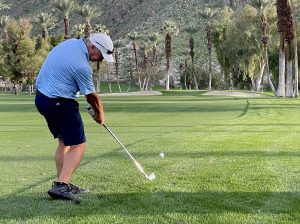
My cousin and I have had an ongoing debate about club fitting for 25 years. He’s a 2-handicaper who’s firmly in the “clubfitting’s nothing but snake oil” school. He buys everything online and “off the shelf.” His bag is a constant, revolving door of experimental clubs. So he heard all the details of my on-going granny shaft saga.
Word of advice: Don’t ever ask your oldest golf buddy / arch-nemesis for club fitting advice.
Any concerns you share about your set of clubs will be amplified 1000 times and used against you. On every tee box. At every opportunity. Especially after you’ve won a couple holes in a row. Imagine my cousin’s delight when he heard I’ve been playing with Granny shafts. I’ll never live that down.
So I was on my own trying to decide whether I should I stick with the advice of my trusted friend Andy, or believe this new guy’s interpretation of the frequency machine data?
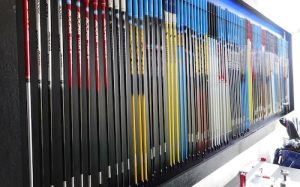
Now at this stage of the story I’m compelled to explain the numbers that club fitters attach to the frequency machine results. An article on Golf WRX calls it “the biggest can of worms there is in club making,” so I’m going to keep it as brief as possible.
Remember how I said there are no industry standards for flex? There are no industry standards for frequency matching charts either. Every company and every fitter can just assign the numbers however they want.
According to that particular fitter, a frequency of 310 cpm is what I need. He described that as “the stiff side of regular flex,” and he was quite sure about that. He showed me his frequency matching chart to prove it.
But I’ve seen frequency matching charts that say 310 is “Stiff.” Another says it’s “Regular.” On most of the charts that I found 291 looks like a perfectly fine number for me, falling on the soft side of “Regular” or the stiff side of “Senior.”
Almost every chart I’ve seen shows 310 with a 6 iron is way out of my physical league. None showed 291 at the bottom of the chart in the granny shaft column. I was so confused!
So I asked Jim Hofmeister about that. “Every company does it differently, uses a little different numbers, and then they’ll turn around and tell everyone else that they’re doing it wrong.” he said.
So if you’re an unscrupulous salesman you could sell a lot of expensive shafts by creating your own frequency chart and showing numbers that “prove” almost everyone needs stiffer shafts.
And vice versa; you could show every lady a chart that paints her clubs as way too stiff and manly. Impossible to play with.
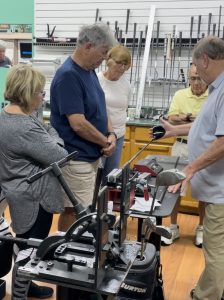
Luckily I had one more ace up my sleeve. John S. Ford is a friend who learned how to fit, build and design golf clubs at McGregor, back in the day when many of the big names were playing that brand. He worked with Jack Nicklaus, Sam Snead, Arnold Palmer, Tom Weiskopf and many other tour stars.
I call him the club whisperer. You can blindfold the guy and he can tell if you’ve hit it on the heel, the toe, or the sweet spot. He’s one of the most meticulous people I’ve ever met, and everything he does has been proven, beyond the shadow of a doubt, over the span of 50 years in the business.
So I boxed up my perfectly good irons and sent them to Florida for a third opinion. I specifically requested confirmation of the frequency numbers and the overall “build” of the set.
What he found didn’t exactly align with what I heard at the fancy, boutique club fitting studio. His chart showed 295 as the magic number for my 6 iron:
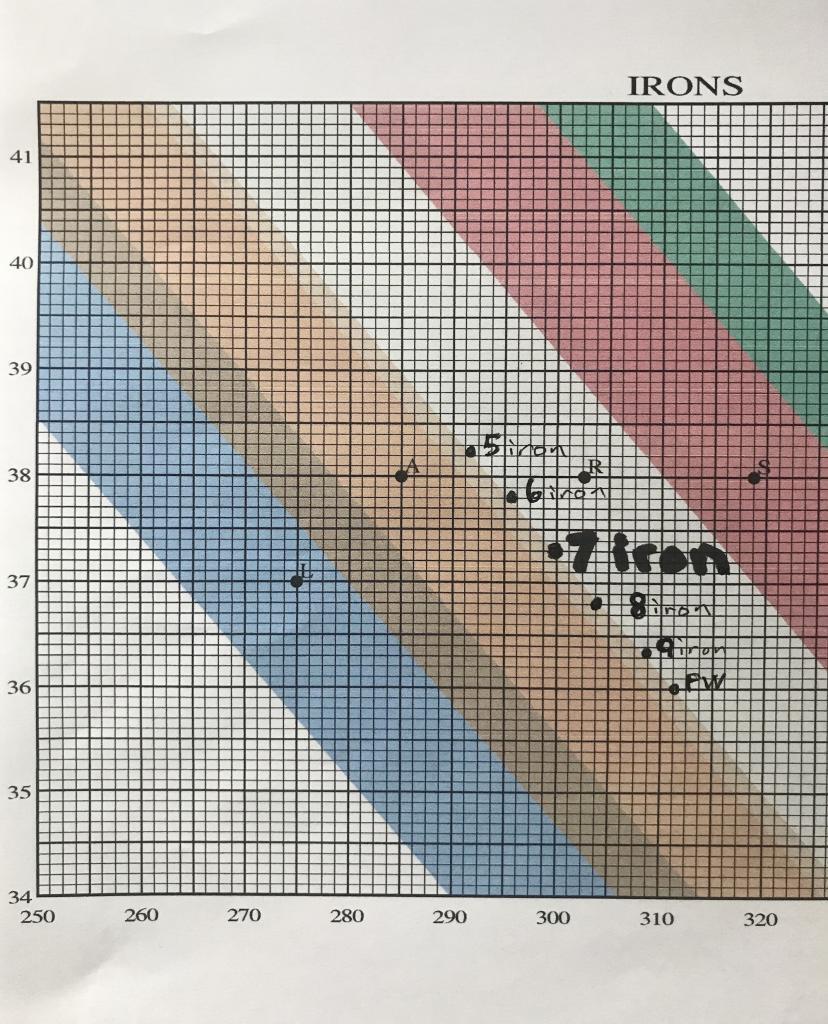
He saw nothing that would indicate my clubs were built incorrectly or “not to spec.” Every shaft was absolutely consistent with the 6 iron. (Notice that my PW shows up on his chart at 310.)
Compared to the thousands of sets he sees every year, Ford said that my Callaway irons were an A grade. “Those matrix shafts are really good,” he said. I hardly ever see any big issues with those.”
All of my irons fell within the spectrum of what he categorizes as “soft regular flex.” Definitely not granny shafts.
Whew! What a relief. Two out of three fitters said my current, lightweight shafts are fine. I can put my wallet away.
His final assessment was this: “Most fitters would just look at your swing speed and say you need a stiffer shaft,” he said, “but the only difference would be trajectory. If you’re not hitting it too high — If your launch angle numbers look good — then forget about it! I wouldn’t worry about the frequency machine numbers or the labels.”
Good answer. While I waited for my Callaways to return from Florida I decided to forget about all the technical club fitting nonsense and just go play golf.
Naturally, my cousin was happy to loan me a random old set of Ping i3 irons, vintage 2000, that were gathering dust in his garage. They had the original, crusty grips and steel shafts marked “stiff.” He was gaming me. Messing with my head.
My first few swings with those eyesore irons were a little bit shaky, but after a few holes I was beginning to believe I could actually play with stiff, heavy, steel shafts.
At the par-5 ninth hole I hit that crusty old Ping 8 iron to four feet. Made an easy birdie. On the 11th hole – a par 3 – I hit 8 iron again and made birdie from 6 feet. Of course I did!
By that point the irony of it was laughable, to say the least. Then on the par-four 13th I hit the most perfectly humorous golf shot of my life. It was that magic old 8 iron again. The one that seemed unfit for human consumption.
The instant the ball left the clubface we started laughing. It was on a rope right at the flagstick. The ball bounced once and rolled 6 feet straight into the cup. Dead center for eagle. I hit the perfect golf shot with a crappy old 8 iron that fit like my grandfather’s suits.
What the hell! I couldn’t have scripted a funnier, more fitting ending. Needless to say, my cousin said “told you so” and offered to sell me his old Ping irons for only $1000!
So what’s the average struggling golfer supposed to conclude from all this? Here are my key takeways that I hope will help anyone who’s thinking of diving into the same club fitting rabbit hole.
The human element is the most crucial piece of the custom club fitting puzzle. It ain’t the track man.
That podcast host didn’t say anything about the biggest, most important variable all: The experience and skill of the fitter. Or lack thereof.
All the data in the world don’t mean squat unless you have someone well trained and impartial to interpret the numbers for you. The fitting technology is only as good as the fitter.
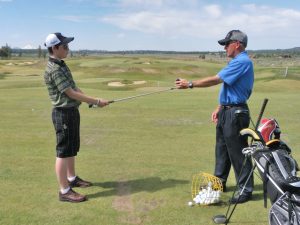
I’m lucky. I have a club fitter who’s also my swing instructor. We’ve been working together for almost 20 years so he can read between the lines and piece this puzzle together intuitively. I have complete, utter faith in him. I doubt very many people can say that about the kid at Golf Galaxy.
There seems to be three different breeds of people in the fitting business: There’s the salesman who’s doing fitting in order to sell as many clubs as he possibly can, at the highest price. The only outcome he’s concerned with is at the cash register.
There’s the craftsman builder/fitter who takes a lot of pride in his work. He genuinely wants to produce the best club he possibly can for every customer. He wants to make the best tools for the job, and he’s happy to show people how to use those tools, to some degree.
Then there are the hybrid contrarians, like my friends Andy and John Ford, who teach AND fit at the same time. These are instructors who understand the symbiotic relationship between golf equipment and golf swings.
So if you’re determined to spend a lot of money on new, custom-made golf clubs, don’t just do a fitting. Shop for a fitter. Find someone with a skilled eye, years of experience, and in-depth knowledge of swing mechanics. Don’t settle for a salesman with a Track Man.
Take every number with a grain of salt.
Beware of the sales guy who just keeps spewing a lot of numbers. I could have easily been swayed into a big purchase because of one number: 310. That was the frequency that I was told I needed in my iron shafts.
Was that fitter just gaming me into buying a new set of clubs for a ridiculously inflated price? I don’t know. I’d rather believe that it was an honest mistake; he just read the numbers wrong, or he grabbed the wrong frequency matching chart, or he didn’t clamp the grip quite right, or the frequency machine was unclean or uncalibrated.
All I know is, his number was not relevant. It did not sync with the TrackMan data and I’m very glad I didn’t spend $2400 on a set of clubs based on that inflated number. I probably would have gone to my grave trying to make those irons work.
You should only use frequency matching numbers to identify faulty shafts and ensure consistency across the set. Pay no attention to the label attached to those numbers.
Swing speed another misleading number that’s routinely over-played by inexperienced club fitters. There’s absolutely no way you can correlate swing speed to a specific shaft flex. The shaft manufacturers provide rough guidelines, but every person is different. Every 90 mph swing is unique. You have to look at the bigger picture.
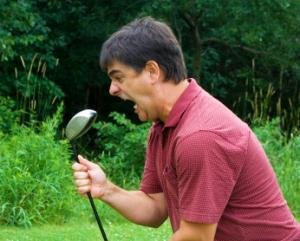
Sometimes, the problem really IS the club, and not your swing.
Faulty shafts are a lot more common than you’d think. In fact, you probably have at least one club, out of the 14 in your bag, that’s just plain wrong in relation to the rest of your set.
It doesn’t take a rocket scientist to figure that out, but it does take a different mindset to do something about it. Most people just blame their golf swing for any bad shots. Even though they haven’t hit a single good shot in three summers with that new 3-wood, they’ll keep trying to figure it out.
Regardless of how much you paid for that unruly golf club, take it out of your bag. Stop trying to make that one work, like I did for years with my Adams driver. It’s an outlier. Stop making excuses. Just get rid of it.
The fact is, even lousy golfers can groove a swing that matches the majority of their clubs. My friend, the club whisperer, sees it all the time.
“I had a guy in my shop just recently who was playing with custom fit clubs that were 5 degrees off on the lie angles,” he said. “He was trying like hell to make those things work. He didn’t have very good golf swing, but it was definitely consistent. And when he saw that ball going right every time, he started changing his swing to compensate. It went from bad to worse.”
You’re likely to develop a lot of bad habits trying to make misfit clubs work for you. Then, if you get clubs that are more “correct,” you’ll have to UNlearn whatever it was you were doing to compensate. So you’re likely to get worse before you get better.
That’s why it’s so helpful to have a club fitter who’s also a good instructor. Guys like Andy can tell the difference between swing faults and equipment issues.
Don’t let ego and confirmation bias sabotage your fitting — or your golf game.
We all have our preconceived ideas of what works and we like, but if you want to get your money’s worth from a club fitting session you have to be open minded and honest with yourself.
This comment recently popped up on a golf group on Facebook: “Just got done with a club fitting. Had to swallow my pride. No more blades for me.”
If a guy believes he needs blades, or stiff shafts, he’ll find data to back up the belief and pretty much ignore any facts that are contrary to that. Andy sees it all the time…
“Even if a guy sees great data from the launch monitor; perfect launch angle, perfect dispersion pattern, perfect spin rate, he won’t buy if the shaft says “senior” on it. He stubbornly insists on what he wants, instead of what you know he needs.”
Skewed perception outweighs reality. Ego wins over common sense. But if you eliminate the senior label and show him the same numbers he’ll defer to the launch monitor data without hesitation.
Several industry insiders I’ve talked with believe they should do away with shaft labels entirely, but no one can agree on numbers that would standardize the process from one manufacturer to another.
So consumers like me are left to believe what the “expert” club fitter tells us. Or not.
The real value is in the placebo effect.
In reality, there’s no way a $400 shaft is going to be four times better than a $100 shaft. You’re not going to get 4x better dispersion pattern. And four extra yards with a five iron isn’t really going to bring your handicap down or make you a better person.
But it’s not about reality. It’s about perception. Belief. Faith. And confidence.
Who cares where the confidence comes from? If money’s no object, knock yourself out. Go ahead and pay top dollar for a very expensive sugar pill.
There’s no doubt that more and more golfers are interested in fitting, and the industry is stepping up to provide it, not only at high-end studios but also at a growing number of big-box stores and pro shops.
But debate about the value of club fitting isn’t going away. On one end of the spectrum you have guys like my cousin who wouldn’t touch custom clubs with a ten foot pole. “When they show me a shaft that’s guaranteed to eliminate my snap hook, then I’ll talk to a fitter. Until then, I’m buying off the rack.”
On the other end you have people who are convinced that their $400 driver shaft is radically superior to any $100 shaft and you’d be an utter fool to settle for anything less. “If you’re not getting fit, you’re crazy.”
I still believe club fitting is quite useful, to a point, but I definitely crossed over into an area that falls into the realm of too much information. The more I researched it, the less I believed.
Club fitting, to some degree, IS important for beginners and high handicappers. Because if they’re trying to play with clubs that are way too stiff, or with lie angles that are 5 degrees off, it’s going to be very hard to see any improvement.
There’s also a clear benefit in club fitting for elite amateurs and pros. No doubt about it. They need every little edge they can get just to stay on the same playing field.
But for the players like myself, who fall in between, I’m not so sure.
I could spend a lot of time and money futzing around with my equipment and never see one iota of improvement. It can be a costly, time-sucking endeavor.
I’d be better off spending my money on a good instructor. One thing’s for sure… $1000 worth of instruction is going produce more improvement than $1000 in club fitting expenses.
If you’re shooting in the 70’s or low 80’s consistently, chances are you could shoot similar scores with just about any set of clubs. Stiff, Regular or even Granny shafts, it wouldn’t matter. You’d make some small adjustments, figure it out, and manage to score.
You might even hole out from 150 yards, like I did with that old Ping iron.

Copyright 2021 John Furgurson – BN Branding All rights reserved. Not for posting, copying or plagiarizing.

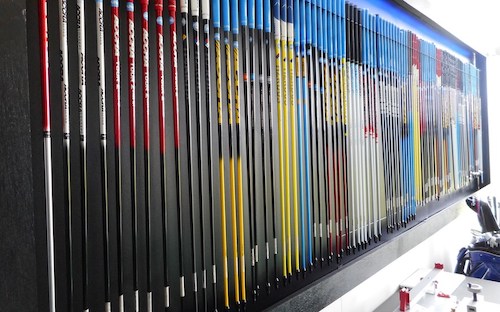
Every article you write elevates my understanding of the game. You’re a true golf guru!
Pingback: Club Fitting Myths That Are Hurting Your Game